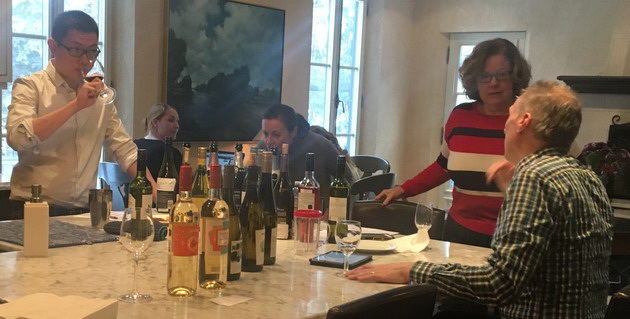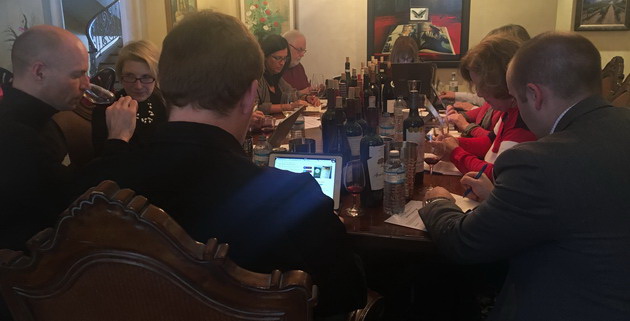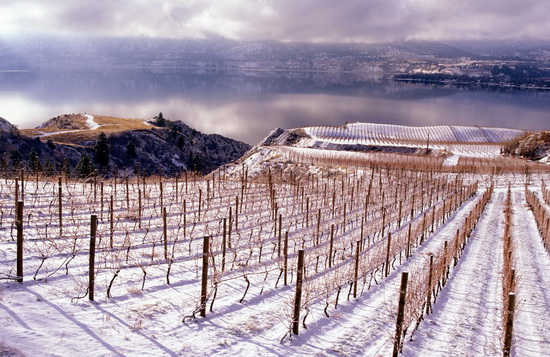In our Facebook Live Video Wine Tasting above, we chat about the difficulty in making icewine and why it’s so expensive.
We also welcome our special guest, Daniel Speck of Henry of Pelham Winery, Niagara, Ontario.
You can click on the arrow above to play the video.
If you’d like to read the 100+ comments, or make a comment yourself, visit:
https://www.facebook.com/natdecants/videos/10154730618869845/
You’ll find the most recent live video wine tasting at the top of the timeline here:
https://www.facebook.com/pg/natdecants/posts/
We taste every Sunday evening at 6 pm eastern so add us to your calendar and grab a glass of wine.
Click on the buttons “Like” and “Share” on the page above to get notified when we go live.
Gwen Barton · Pairs with spiced nuts (tried this at Christmas- lovely)
Henry Pelham · Thanks for the nice words Natalie — we are very lucky to get to do what we do and my bros and I are thankful to live in Canada — it’s a great place to live and do business.
Doug McMillan · I had a 15 year-old Inniskillin icewine a few years ago, Definitely aged; it was amber. I got impression that this was an unusual thing to do.
Lise Charest Gagne · with icewine i do not see mixed grape varieties – Nat or other in the know is there a reason for that? I do notice that the red varieties are much more expensive (b/c the red grapes are not as hardy?)
Lori Kilmartin · I really enjoyed the Sperling!
Lise Charest Gagne · 300L/T wow surprising – how do you know when to pick Dave? Also any niagara producers that allow tours during that process
Ronald Vana · Yes I only bring the Ice wine back to Netherlands when I’m in Qc
Henry Pelham · I love Riedel glasses — but only because I like to drink from nice chrystal. Im not a strong believer in the importance of the shape of a glass other than it should be tulip shaped (more or less)
Henry Pelham · Icewine when opened will ,last for several weeks if kept refrigerated. Always best when fresh but okay for many weeks later and can always be used for cooking
Henry Pelham · Stratus is a great winery — great people making great wine. Love their iconic Stratus Red and Stratus White especially, but you won’t go wrong with any of their offerings.
Henry Pelham · Icewine has become an important export wine for us — it opened alot of doors for us, and now our still wines follow. Still wines are now following — especially top end!
Henry Pelham · 2016 will be remembered as one of the warmest vintages in history — and even quite mild (bt CDN standards) in Nov/Dec), so there were concerns about losing some of the crop, but finally yields came in about where we wanted them.
Henry Pelham · Yes, Vidal is the main varietal as it has thick skins and so is quite resistant to rot. It also makes a delicious bottle of wine! But Riesling is arguably the finest varietal — yet it’s thinner skinned and more susceptible to rot (remember that these grapes hang quite late on the vine). In the Short Hills Bench we get cold weather sooner, so we can specialize in Riesling, which we are very happy about!
Henry Pelham · We like to pick fast and furious, then take time to press (but not too much time). 2015 vintage was harvested very late — Jan 2016. The yields were low as the grapes hang so long. The blessing was that even though the yields were low, because there was so much concentration, on half as much fruit we got close to the same L/tonne as needed — freaked us out but worked out in the end!
Bob Levesque · The Lcbo in Brampton has a very poor selection of icewine and is in the gift section.
Bob Levesque · How long will an open bottle of icewine last in the fridge?
Lise Charest Gagne · ice wine is surprisingly good with my husbands beer batter vidalia onion rings – were drinking Kaiken very full body with local beef burgers
Lise Charest Gagne · Dan any ice wine with apples emerging from your areas they are from QC
Gwen Barton · My father-in-law loves “ice wine and brandy” – not sure if this is sacrilegious.. I prefer the pure stuff 😊
Ronald Vana · would recommend esp blue cheeses pairing of strong flavours
Ronald Vana · how long does fermentation take? Any difference between stainless and oak fi the Oak Aged Vidal of Peller?
Henry Pelham · Yields in icewine vs still wine — about 300L/tonne for icewine vs 720 L for still wine — but remember that it’s not just the L/tonne that make icewine costly — we also lose much of the crop to drying out on the vine and weathering etc
Henry Pelham · Ann Sperling has been making wine for many years in Ont, BC and Argentina. She does a great job at Southbrook (Niagara) but also at her family’s estate in BC — haven’t tried Argentina but have NO DOUBT that those wines will be great too based on her other efforts.
Henry Pelham · in the winter all the furry and feathered critters are looking for good eats, and that is icewine grapes!
Henry Pelham · It may seem extravagant, but try drinking Icewine or Late Harvest with a spicy curry — it really does work!
Henry Pelham · I also like to put an 1/2 to 1 ounce of Riesling icewine with Cuvee Catharine Brut — we call this a Kir Catharine (or a Blushing Kir Catharine if Rose Brut is used)
Henry Pelham · my fav way to drink icewine is before a meal — I have it with charcuterie and strong cheeses
Henry Pelham · We generally do not blend icewines — we make them as varietals and like to feature both the varietal character and the terroir
Henry Pelham · Fermentations are longer than for still wines — can take a few weeks depending on styles etc.
Henry Pelham · Fakes — yes, as with all luxury this is an issue in Asia for all wines. Let’s sign a free trade deal w/China and work out rules
Henry Pelham · 2016 is technically the vintage even though they may be picked into Jan of the following year. THIS YEAR WE WERE VERY LUCKY TO PICK BEFORE X-MAS.
Henry Pelham · Icewine is like mobilising the military! We have to be prepared for the perfect window of time and then go for it. A combo of hand harvesting and mechanical harvesting is used so that we can pick as fast as possible — usually we are targeting -11 C, middle of the night! Never easy!
Henry Pelham · The deer are the biggest issue so we net the vines — wild turkeys are an issue too.
Bob Levesque · From Brampton here. Trying the Inniskillen Vidal tonight.
Lori Kilmartin · What temperature were you picking at Dan?
Lise Charest Gagne · Dan when is the wine released in general – the following year ?
Lise Charest Gagne · Bella Vitano cheeze with ice wine is spectacular
Lise Charest Gagne · Hello Miss Natalie – love my Vin de Glace :)
Lise Charest Gagne · I wish the bottles were bigger
Ronald Vana · Any idea how the Swenson White compares to Vidal
Ronald Vana · Is the Vidal grape the most used one for Ice Wine?
Doug McMillan · Thanks for making such great wine Dan!
Henry Pelham · It’s /REE-dl/ as in rhymes w/needle
Henry Pelham · Gewurtz is a tricky grape to work with for icewine/Late Harvest as it likes to break down in the vineyard prior to harvest — so hats off to those who do it and do it well — Reif is an icewine pioneer from the early days of the ONT wine industry. My second favourite winery in Niagara is Hidden Bench :-) — Harold is a class act, Marlise delivers the goods — the measure of quality is the hard years. try their wines in the more difficult vintages and you’ll be shocked at how good they are– they really go the extra mile
Lise Charest Gagne · Can you comment on the cab franc grape and why its so much more $$ – sinfully delicious in my opinion especially with some raspberry washed Bella Vitano cheese
Henry Pelham · For those of you who have icewines hiding in the closet — they do age! Riesling’s while young have a citrusy character that becomes like marmalade when aged. Vidal goes from fresh mango and peaches and evolves into toffee flavours — really delicious.
Below at our team tasting earlier that day, we sampled a range of terrific icewines. Here are a few of our favourites …
Jennifer MacDonald Havers
Wine Columnist, Ottawa Citizen
Stratus Red Icewine 2007
Niagara-On-The-Lake, Ontario VQA, Canada
Greg Hughes
Wine Writer& Sommelier
Inniskillin Niagara Estate Vidal Icewine 2015
Niagara Peninsula, Ontario V.Q.A., Canada
Melanie Aubert
Sommelier & Blogger
Sperling Gewürztraminer Icewine 2014
Okanagan Valley, British Columbia V.Q.A., Canada
Sharon Prionas
Wine Blogger
Henry of Pelham Winery Riesling Icewine 2014
Niagara Escarpment, Ontario V.Q.A., Canada
![]() A wine columnist is urging Canadians to drink icewine while cheering on the country’s Olympians next month.
A wine columnist is urging Canadians to drink icewine while cheering on the country’s Olympians next month.
“It’s Canada’s winter gold. I can’t imagine a better way to celebrate our Canadian winters. I kind of think about our Canadian athletes too and I think we all should be drinking icewine while watching the Olympics,” says Natalie MacLean, editor of a wine review site, which has more than 156,000 members.
“It’s uniquely Canadian in that we are the biggest producer and the best producer, I think, in terms of quality. It’s just such an all-Canadian treat that I think people need to at least try it to experience what it is we do so well here.”
Canada stands at the top of the icewine podium, with almost 100 wineries out of 500 that last year produced 2.5 million bottles worth $70 million retail. The country’s icewine has won numerous gold medals internationally.
While Germany and Austria also make the sweet beverage, their winters are not cold enough to consistently produce icewine every year.
Icewine makers must deal with the whims of Mother Nature.
“I do think they are the true athletes of the vine, those who make icewine. It’s like extreme winemaking,” MacLean said by telephone from Ottawa.
“I think it’s one of the toughest types of wine you can make on this planet because of the natural conditions that have to be there to produce this.
“They have to endure all of that — harvesting at -8 C or colder and so on, very difficult fermentation process because of high sugar. But then the artistry comes out.”
Icewine is pricey due to the production process. Still icewines can range from $25 to $60 for a 375-millilitre bottle, while sparkling icewines can cost up to $80 for the same size.
In Canada, winemakers producing true icewines must follow strict standards determined by the Vintners Quality Alliance.
Icewine is produced from grapes that have been left on the vine after the fall harvest. When temperatures drop to -8 C or lower, the frozen grapes are picked, typically at night, and pressed immediately, with winemakers working around the clock in sub-zero conditions.
“A lot of growers will pick down to -12 C, but at -14 it’s really hard to get any juice out of those little frozen pellets,” explains MacLean. “At -16 they won’t yield anything. They’ll just break your press. They’re ice marbles.”
In Ontario’s Niagara region, the harvest started early as the temperature began to dip below -8 C in late November, the Wine Council of Ontario said in a news release.
“It’s all about the concentration of the flavours,” says MacLean. “That’s what you’re looking for. That’s what has happened to these grapes.
“They’ve frozen, but in the meantime because they were freezing and thawing, freezing and thawing throughout December that made the flavours more complex and then it also dehydrated the grapes, so what you’re left with is a concentration of flavour and sugar which makes the complexity of the wine.”
There are some Quebec producers who call what they make icewine, but the grapes are not naturally frozen on the vine and picked at -8 C, says MacLean.
Icewine is thought to have been accidentally discovered in Germany in 1794 when farmers tried to save their grape harvest after a sudden frost.
Hainle Vineyards in British Columbia’s Okanagan Valley was the first Canadian winery to make the wine that is renowned for its intense flavour and smoothness. In 1978, the winery released its first batch of commercial icewine, becoming North America’s first icewine producer.
Ontario now produces the lion’s share of the country’s icewine, while British Columbia is next, then Nova Scotia and Quebec. Much of Canada’s icewine is exported to China.
Icewine should be served well chilled. A regular white wine glass allows enough room to swirl the wine and enjoy its aromas.
Even though it’s sweet, don’t think of it as only suitable with dessert. Try it at the beginning of a meal with nuts and cheeses or foie gras.
Icewine can also be served during a meal with a glazed ham or something with a bit of sweetness or caramelization. “Icewine is low in alcohol, it’s not cloyingly sweet, it’s got the balancing acidity, so it will surprise you in its diversity and complexity,” says MacLean.
Port and sherry clock in at about 19 per cent alcohol content. Icewine is usually 10 or 11 per cent.
Several communities across the country are hosting events to celebrate the liquid gold.
The Niagara Icewine Festival runs till Jan. 26. Events in the 17th annual festival are being hosted throughout the region, where visitors can admire sparkling ice sculptures, warm up to open fires and enjoy live entertainment.
Sun Peaks Resort in British Columbia hosts its 16th annual Winter Okanagan Wine Festival until Sunday, and showcases local icewines and table wines along with food and outdoor recreation.
In the Maritimes, several local wineries are collaborating on special icewine tours and tasting events during the Nova Scotia Icewine Festival, part of Winter in Nova Scotia Wine Country, which runs Feb. 7-16.
Posted with permission of Canadian Press.
Canadian Icewine: Extreme Winemaking
Natalie: Ice wines come in a variety of styles, made from a variety of grapes and therefore there’s a whole world out there of food pairings. A lot of people tend to think of ice wine as only a dessert wine but it’s much more than that. It can start at the beginning of the meal much like we might crack open a French Sauternes with foie gras or cheese or nuts. Where I’d start is with this Sparkling ice wine from Inniskillin. It’s a red based grape and the effervescence; the bubbles, are going to lessen the perception of the sweetness. Even though the sweetness is the same, so this is a terrific one for grapes, nuts and that sort of thing at the beginning of the meal.
Then as we progress, we go to Vidal … mouth coating, beautiful apricot, tropical fruit notes in this. You think fruit flans and cobblers, a really viscous, mouth feeling kind of wine.
As we continue along, we have a Sauvignon Blanc which is going to be just like in the dry version. It’s going to offer more citrus notes, more lime and clementine. So again you can go with those fruit-based desserts that have a bit more zing and tang and acidity to them.
As we continue along, we have a Riesling, which is that finicky grape, but it provides sublime balance. You have the acidity balancing the sweetness.
Finally, if we go over to Cab Franc we’re into a red based grape again and you’re going to get those strawberry-raspberry notes and now we can get into the really dark sort of chocolate truffles and darker richer desserts. So you can see there’s a whole range from front of the meal to end of the meal or just a glass on its own. I would pair ice wine with more ice wine, if I were you.

















